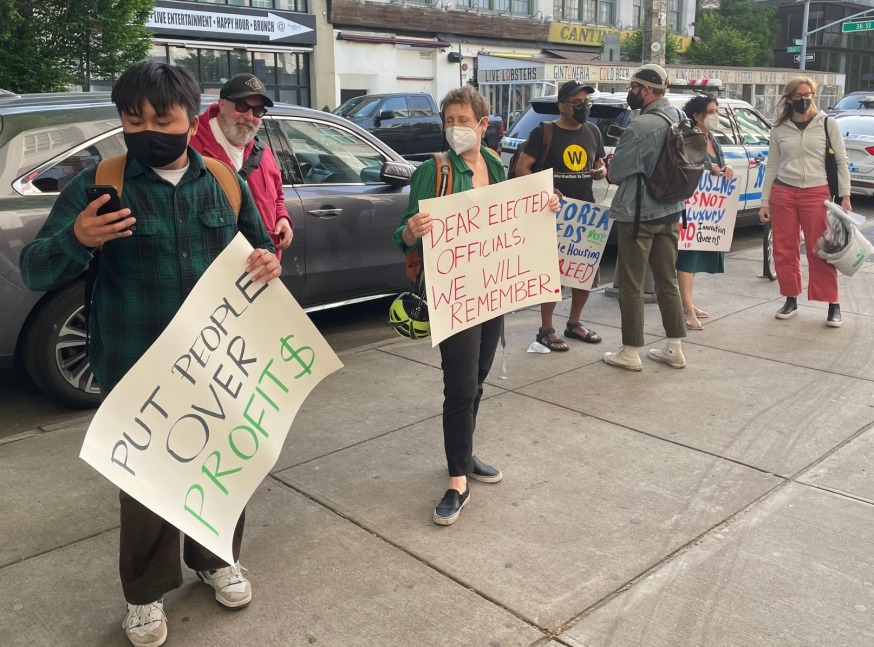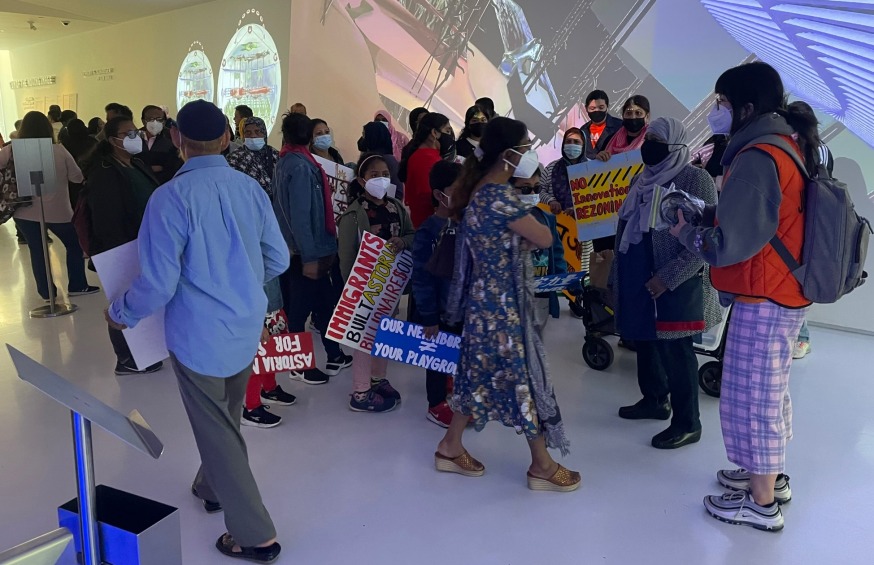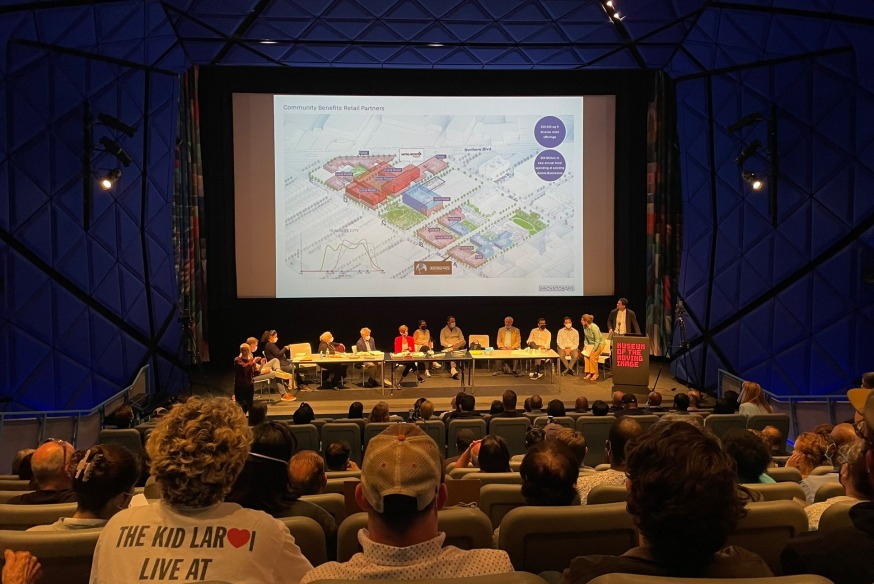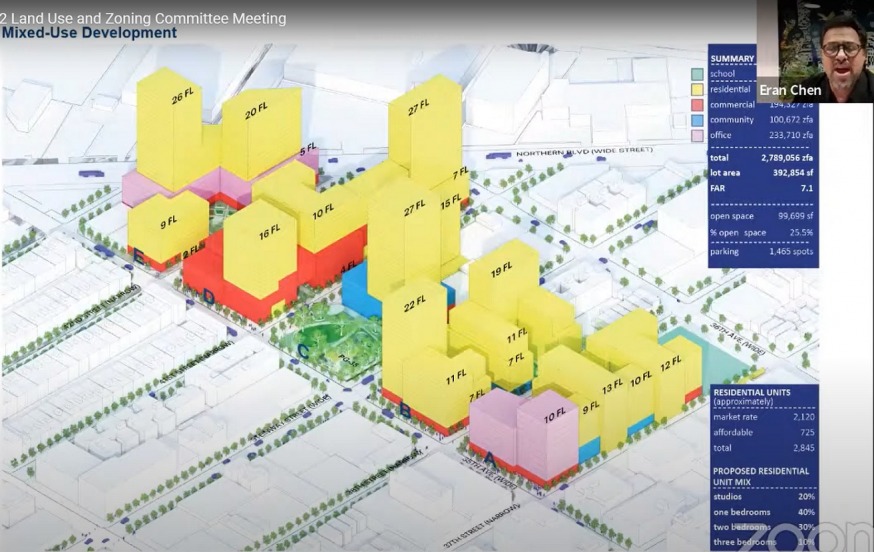
Protesters outside the Museum of Moving Image Wednesday night where a public hearing concerning the Innovation QNS proposal was taking place (Photo: Queens Post)
May 26, 2022 By Christian Murray
Tempers flared and opinions were mixed Wednesday night when Community Board 1 held a public hearing where the merits of a rezoning application that would bring 2,800 apartments to a five-block area in Astoria were debated.
The hearing was held at the Museum of the Moving Image (MoMI) and the 267 seat auditorium was packed to capacity, with a line to get in. Approximately 100 people registered to testify, with about 80 speaking. Of the speakers, about half were for it and half against.
Both the advocates and opponents of the Innovation QNS project were well organized. The nonprofit organizations and business leaders that stand to gain from the project turned out to speak in support of it, while tenants’ rights groups arrived armed with signs, leaflets, and speakers to oppose it.
There were long lines to get into the venue, with protesters holding signs outside MoMI that read ‘Astoria is Not for Sale’. In addition, there were Bengali residents who live near the proposed development site holding a rally in opposition to it. There was also a noticeable police presence.

Protesters line up at the Museum of Moving Image Wednesday night where a public hearing concerning the Innovation QNS proposal took place (Photo: Queens Post)

A public hearing was held at the Museum of Moving Image Wednesday night where the Innovation QNS proposal was discussed (Photo: Queens Post)
The meeting represented the first step in the public review process—known as ULURP– that the developers must go through in their quest to rezone five city blocks.
The application has been filed by a team of developers consisting of Silverstein Properties, Kaufman Astoria Studios and BedRock Real Estate Partners that plan to create a mixed-use district between 37th Street and Northern Boulevard, bound by 35th and 36th Avenues. The development would consist of more than a dozen buildings that would range in height from eight to 27 stories.

The plan presented by the developers during Community Board 1’s Land Use and Zoning Committee meeting on Feb. 16 (Screenshot). Since then, the 9 story building on 35th Avenue has been lowered to 8 stories, with the bulk from the lost floor allocated elsewhere in the development.
Several executives of local non-profits that have a stake in the project testified in support. These included representatives of Jacob A. Riis Settlement, HANAC, the Floating Hospiital, MoMI and the LGBT Network. All these groups, along with Urban Upbound, have been promised space or a management role in the new development.
“We fully support the Innovation QNS project,” said Cynthia Davis, director of outreach for the Floating Hospital. ”There is a lack of essential services and Innovation QNS will bring much needed community organizations. Developments like this are among the few opportunities to bring in services like this.”
Business organizations such as the Queens Economic Development Corp, the Steinway Astoria Partnership and the Long Island City Partnership had representatives who spoke in support of the project saying that it would boost the local economy.
Tony Barsamian, chair of the Steinway Astoria partnership, said that the small business owners along Steinway Street support the project since it would bring much-needed foot traffic.
“The stores need shoppers, this will bring thousands of shoppers to the block,” he said.
Several residents from NYCHA housing also advocated for the project, saying that it would bring much-needed jobs.
Claudia Coger, a longtime resident of Astoria Houses and a past president of the Astoria Houses Tenants Association, said she was in support of the project, noting that it would revitalize the area.
“As a city, we’re growing and we have to be able to understand that. We must open our minds to growth here in Astoria.”
The advocates also argued that there is a housing crisis and that the 2,800 units would bring much needed apartments to an underutilized area that consists mainly of warehouse space. They also said that it would activate the area and also bring 2 acres of much-needed green space.
The developers noted that 711 of the 2,800 units would be affordable apartments. They also said that 100 of the affordable units would be set aside for seniors, which would be managed by HANAC.
The project would also include 250,000 square feet of office space, 200,000 square feet of retail offerings, 100,000 square feet of community space and 1,465 parking spaces.
The opponents of the project, however, said that the plan would raise rents and bring luxury housing that was not needed. They argued that there is an affordable housing crisis—and that the number of affordable units being offered at truly affordable levels was not enough.
“This will bring 2,100 luxury, unaffordable units to this diverse, working-class part of Astoria,” said Jenny Dubnau, a local artist and activist opposed to the project. “The other 700 units deemed affordable are not affordable to most people who live here. There are only 284 apartments pegged to the lowest income levels out of 2,800 total apartments.”
Another speaker echoed Dubnau’s statements.
“We have an affordable housing crisis, and these developers are offering a project that offers the bare minimum,” said Mason Van Gieson. “I’m urging you to vote against Innovation QNS because we can, and we should do better. We do have a housing crisis in New York City. But it is first and foremost an affordability crisis.”
Van Gieson went onto say that the development will lead to the displacement of many residents. “An influx of luxury units will raise area rents and property taxes, which will price people like me and my neighbors out.”
The opponents of the plan were loud, and at times the meeting was tense.
One speaker, Marino Frost, who lives and operates a business on a site slated to be part of the project, tried to speak longer than the one minute allotted for each speaker to testify– and was cut off mid sentence.
Tom Ryan, a member of Community Board 1, told Frost to stop speaking, which sparked controversy.
Ryan then touched Frost as a means to escort him away. Opponents yelled angrily at Ryan, requiring Community Board 1 Chair Marie Torniali to tell the audience to “chill.”
Community Board 1 is likely to reject the application based on the findings of a board subcommittee that was created to evaluate the project.
“Community Board 1 has historically been pro development when a project is reasonable and when the community at large will benefit,” said Gerald Caliendo, co-chair of CB1’s Land Use & Zoning Committee. “But it was agreed by the subcommittee that the project is somewhat detrimental to the community.”
Caliendo said that subcommittee viewed the scale of the project as being out of character with the adjoining residential blocks. The project, he said, needed to be much smaller on 35th Avenue, with the scale more focused on Northern Boulevard.
The subcommittee also said that much of the open space acted like a commercial corridor, as opposed to true park space. The subcommittee, Caliendo said, determined that there was a need for active recreation space such as basketball courts or a small soccer field.
Caliendo said the subcommittee’s findings will be presented to the Land Use & Zoning committee, which is likely to vote against it. It will then be referred to the full board.
The full board is required to vote on the plan before the end of June. The board’s vote is advisory and a no vote won’t nix the plan.
The plan will then go to Queens Borough President Donovan Richards who will have 30 days to make a recommendation. His recommendation will also be advisory.
The City Planning Commission will then have 60 days to vote on it. The CPC vote is typically binding, where its rejection—which is rare– would terminate an application.
The final step in the process is for the plan to go before the city council, which ultimately decides the fate of the application.
Councilmember Julie Won, who represents the district, has shown little enthusiasm for the project. She will essentially determine its outcome.
One Comment







Where is the transportation infrastructure to support this? The nearby subways and buses are already too crowded. And where are the parking spot for residents in 27-story apartment buildings and for shoppers?